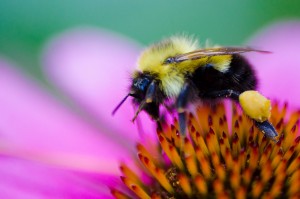30
Nov
Studies Add to Mounting Evidence of Neonic Dangers
(Beyond Pesticides, November 30, 2015) Last week, two studies were published that link neonicotinoid (neonic) insecticide exposure to detrimental effects in bees and butterflies. The first study, published in the international scientific journal Nature, found that bumblebees exposed to neonics suffered pollination services impairment that reduces their delivery to apple crops. The second study, published in the United Kingdom journal Peer J, used over 1,000 sites cataloged from 1984 to 2012 in the UK Butterfly Monitoring Scheme (UKBMS) database to point to the strong association between neonic use and butterfly population decline.
 These studies contribute to the mounting evidence that neonic insecticides are linked to pollinator decline. Neonics have increasingly been the subject of recent studies that highlight a causal relationship between neonic exposure  and harmful effects to pollinators, like foraging and reproductive complications. These effects are being identified by scientists all over the world, gradually negating industry criticism of study design.
These studies contribute to the mounting evidence that neonic insecticides are linked to pollinator decline. Neonics have increasingly been the subject of recent studies that highlight a causal relationship between neonic exposure  and harmful effects to pollinators, like foraging and reproductive complications. These effects are being identified by scientists all over the world, gradually negating industry criticism of study design.
Andre Gilburn, PhD, and ecologist at the University of Stirling, led the butterfly study. He said, “Our study not only identifies a worrying link between the use of neonicotinoids and declines in butterflies, but also suggests that the strength of their impact on many species could be huge.” While the  study authors find  that the main cause for butterfly decline is habitat deterioration, they conclude that neonic use is either acting as a proxy for or helping to quantify the agricultural intensification that is contributing to habitat deterioration. They recommend a more intensive look at neonics to determine their widespread toxicity to butterflies.
In other recent studies, glyphosate has been linked to  the  decline of monarch butterflies, whose sole source to lay their eggs, milkweed plants, are being devastated as a result of glyphosate-resistant genetically engineered crops.
University of Guelph professor, Nigel Raine, PhD, who headed the bumblebee study, said, “Until now, research on pesticide effects has been limited to direct effects on bees themselves.” Dr. Raine’s work points to the synergistic effect on bumblebees in field conditions due to neonic exposure. Recently, French scientists addressed  the issue of  inconsistent lab and field conditions  by analyzing reproductive effects in honey bees in field studies. The results show that  harmful effects to individual honey bees can hurt a hive long-term. A study released in October found that neonics severely affect queen bees by decreasing their egg-laying abilities, altering reproductive development and causing death. In February, Scottish scientists discovered that the levels of neonicotinoid (neonic) pesticides bees are likely to encounter in the wild impair the pollinator’s brain cells, resulting in colony declines. The results of recent studies and the newest bumblebee study all point to a threat to the overall sustainability of colonies and long-term effects of neonic insecticides.
Bumblebees are major pollinators of apples and many other important crops around the world. Together with other wild and managed insects their pollination services to crops are valued at close to $500 billion CDN worldwide every year,” said Dr. Raine, pointing to the serious implications of pollinator decline.
While the U.S. Fish and Wildlife Service  banned the use of neonics  on National Wildlife Refuge Land, and the White House Council on Environmental Quality  released new guidelines  prohibiting the planting of neonic-treated plants at federal facilities, EPA and U.S. Department of Agriculture (USDA) have taken little substantive action. Although EPA recently proposed  modest label changes  to protect bees from acute pesticide exposure, USDA submitted comments criticizing the agency’s proposed rule, saying that it had “not established the need for such a prohibition.” In fact, USDA has gone as far as suppressing and targeting its own scientists  who  have linked neonics to bee-toxic effects.
The  Saving America’s Pollinator’s Act of 2015  remains an avenue for Congress to address the pollinator crisis.  Contact your U.S. Representative  and ask them to support this important legislation today. You can also get active in your community to protect bees by advocating for policies that restrict their use. Montgomery County, Maryland recently  restricted the use of a wide range of pesticides, including neonics, on public and private property.  Sign here  if you’d like to see your community do the same!
All unattributed positions and opinions in this piece are those of Beyond Pesticides.










